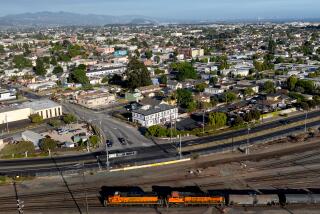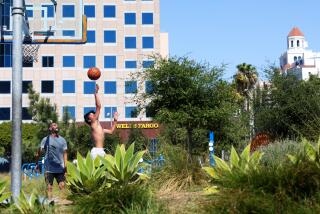Against the odds, Vegas paper wins
No news outlet did a better job in sorting out the bewildering financial meltdown last year than the New York Times. The St. Petersburg Times transcended hyper-partisan Campaign 2008 with its no-nonsense “PolitiFact” website.
Those two news organizations rose to the occasion on the two biggest stories of the year. I can’t say enough about what great work they did, or how tickled I am that both lost out in the competition for journalism’s top prize.
The Pulitzer Prize for public service went not to those blockbuster, brand-name finalists but, instead, to a little newspaper hardly anybody’s heard of, published in a town nobody associates with the search for truth.
The Las Vegas Sun and the Pulitzer board in faraway New York struck a blow this week for gritty, one-person, no-back-down reporting. The paper’s triumph also raised questions about whether it represents a new paradigm -- newspapers forsaking small game in search of the big kill.
Those questions mostly took a back seat Monday as the Sun blinked into the bright lights of its new fame. Staffers first went mute, then incredulous (one newsie, when told of the victory, demanded: “How do you know?”) then giddy at being only the second Nevada newspaper to win a Pulitzer.
(The Reno Evening Gazette and Nevada Journal won in 1977 for editorials challenging a state power, the owner of the Mustang Ranch brothel.)
Sun reporter Alexandra Berzon brought home the prize with more than 50 stories that, as the Pulitzer board said, exposed “the high death rate among construction workers on the Las Vegas Strip amid lax enforcement of regulations, leading to changes in policy and improved safety conditions.”
Berzon, who came to her job at the Sun in December 2007 from the UC Berkeley Graduate School of Journalism and an online tech publication, may be one of the few reporters who got her Pulitzer-winning assignment in a job interview.
Deputy Managing Editor Drex Heikes had been reading repeated items in the rival Las Vegas Review-Journal about workers dying at massive hotel and resort construction sites. Short on reporters, he asked Berzon, 29, during her interview if she would be willing to try to figure it out.
Berzon told me: “That sounded like something I could sink my teeth into.”
Berzon pressed ahead even as union bosses, state regulators and casino owners tried to build a case that an unprecedented $32-billion building boom made more worker deaths nearly inevitable.
A couple of Pulitzer jurors told me they loved the one-woman-against-the-system nature of the investigation, which looked at 12 worker deaths over 18 months.
The body count stopped climbing only after the Sun brought attention to the problem and to the shoddy oversight by state regulators.
True to form, Berzon didn’t pay any attention to the Pulitzer announcements Monday morning, instead following a court hearing related to another worker death. She learned about the award only when she returned to the newsroom.
The Sun has styled itself as the crusading upstart for more than half a century, much of it under the direction of Herman “Hank” Greenspun, a flamboyant entrepreneur who battled Joe McCarthy and built a Vegas housing empire. But, like a lot of afternoon dailies, the paper struggled to make money. It remained on life-support for years because of an agreement that allowed it to share operations -- and profits -- with the dominant Review-Journal. That arrangement took another twist in late 2005, when the big morning paper and Sun began to be packaged and delivered as one.
That probably marks another first -- a Pulitzer winner that appears not as a free-standing paper but tucked inside the competition.
Hank’s son, Brian, and his managing editor, Mike Kelley, decided it would be foolish, and a losing proposition, to compete for breaking news with the R-J. Instead they brought in new editors, including Heikes, former editor of the Los Angeles Times Magazine, and decided to devote their eight daily pages to in-depth stories and investigations. (The Greenspun family owns a stake in Tribune Company, which owns the Los Angeles Times, and Brian is on Tribune’s board of directors.)
“I think they have hit their stride and it has become a really, really good newspaper as far as I’m concerned,” said Steve Sebelius, editor of the alternative Las Vegas City Life, which is owned by the company that owns the Review-Journal.
A passel of journalism commentators have been urging papers to make like the Sun -- reducing blow-by-blow news coverage in favor of more in-depth pieces that other media can’t duplicate.
But others insist the public still wants to know about the ball scores, city council votes and crime blotter.
Even Heikes, champion of the long-form reporting, concedes other papers wouldn’t have the luxury of chucking those daily responsibilities. “The R-J does a lot of what a newspaper still needs to do and the Sun doesn’t have to do,” Heikes said. “We can exist only alongside of them.”
But the Sun has been beefing up its website and breaking more news online, looking to a day when printed papers may be smaller or disappear altogether. Then maybe the Sun would have to provide both small news bites and full meals.
That model hasn’t put the Sun into the black. But the younger Greenspun keeps on investing, in hopes the journalistic gold will one day produce some old-fashioned green.
--
More to Read
Sign up for Essential California
The most important California stories and recommendations in your inbox every morning.
You may occasionally receive promotional content from the Los Angeles Times.











